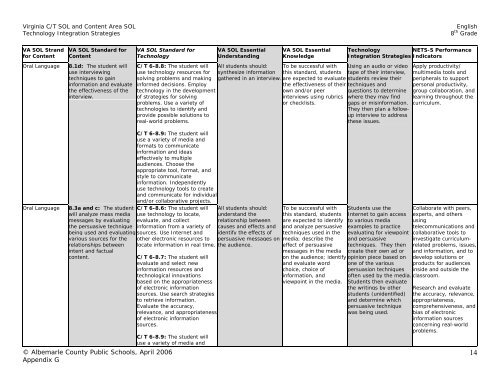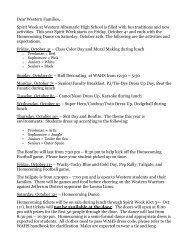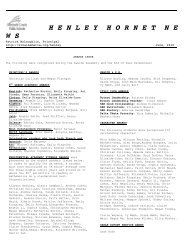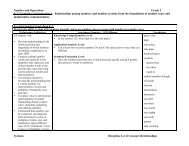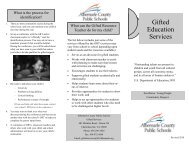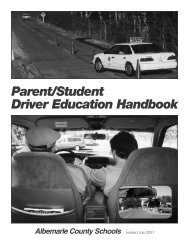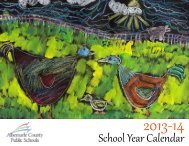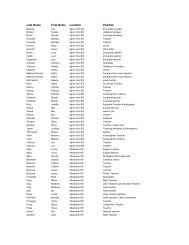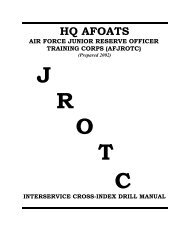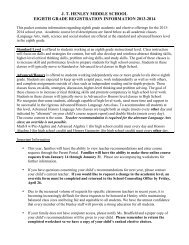Language Arts/English Curriculum Frameworks - Albemarle County ...
Language Arts/English Curriculum Frameworks - Albemarle County ...
Language Arts/English Curriculum Frameworks - Albemarle County ...
You also want an ePaper? Increase the reach of your titles
YUMPU automatically turns print PDFs into web optimized ePapers that Google loves.
Virginia C/T SOL and Content Area SOL <strong>English</strong><br />
Technology Integration Strategies 8 th Grade<br />
VA SOL Strand<br />
for Content<br />
Oral <strong>Language</strong><br />
VA SOL Standard for<br />
Content<br />
8.1d: The student will<br />
use interviewing<br />
techniques to gain<br />
information and evaluate<br />
the effectiveness of the<br />
interview.<br />
VA SOL Standard for<br />
Technology<br />
VA SOL Essential<br />
Understanding<br />
C/T 6-8.8: The student will All students should:<br />
use technology resources for synthesize information<br />
solving problems and making gathered in an interview.<br />
informed decisions. Employ<br />
technology in the development<br />
of strategies for solving<br />
problems. Use a variety of<br />
technologies to identify and<br />
provide possible solutions to<br />
real-world problems.<br />
VA SOL Essential<br />
Knowledge<br />
To be successful with<br />
this standard, students<br />
are expected to evaluate<br />
the effectiveness of their<br />
own and/or peer<br />
interviews using rubrics<br />
or checklists.<br />
Technology<br />
NETS-S Performance<br />
Integration Strategies Indicators<br />
Using an audio or video<br />
tape of their interview,<br />
students review their<br />
techniques and<br />
questions to determine<br />
where they may find<br />
gaps or misinformation.<br />
They then plan a followup<br />
interview to address<br />
these issues.<br />
Apply productivity/<br />
multimedia tools and<br />
peripherals to support<br />
personal productivity,<br />
group collaboration, and<br />
learning throughout the<br />
curriculum.<br />
Oral <strong>Language</strong><br />
8.3a and c: The student<br />
will analyze mass media<br />
messages by evaluating<br />
the persuasive technique<br />
being used and evaluating<br />
various sources for the<br />
relationships between<br />
intent and factual<br />
content.<br />
© <strong>Albemarle</strong> <strong>County</strong> Public Schools, April 2006<br />
Appendix G<br />
C/T 6-8.9: The student will<br />
use a variety of media and<br />
formats to communicate<br />
information and ideas<br />
effectively to multiple<br />
audiences. Choose the<br />
appropriate tool, format, and<br />
style to communicate<br />
information. Independently<br />
use technology tools to create<br />
and communicate for individual<br />
and/or collaborative projects.<br />
C/T 6-8.6: The student will<br />
use technology to locate,<br />
evaluate, and collect<br />
information from a variety of<br />
sources. Use Internet and<br />
other electronic resources to<br />
locate information in real time.<br />
C/T 6-8.7: The student will<br />
evaluate and select new<br />
information resources and<br />
technological innovations<br />
based on the appropriateness<br />
of electronic information<br />
sources. Use search strategies<br />
to retrieve information.<br />
Evaluate the accuracy,<br />
relevance, and appropriateness<br />
of electronic information<br />
sources.<br />
C/T 6-8.9: The student will<br />
use a variety of media and<br />
All students should:<br />
understand the<br />
relationship between<br />
causes and effects and<br />
identify the effects of<br />
persuasive messages on<br />
the audience.<br />
To be successful with<br />
this standard, students<br />
are expected to identify<br />
and analyze persuasive<br />
techniques used in the<br />
media; describe the<br />
effect of persuasive<br />
messages in the media<br />
on the audience; identify<br />
and evaluate word<br />
choice, choice of<br />
information, and<br />
viewpoint in the media.<br />
Students use the<br />
Internet to gain access<br />
to various media<br />
examples to practice<br />
evaluating for viewpoint<br />
and persuasive<br />
techniques. They then<br />
create their own ad or<br />
opinion piece based on<br />
one of the various<br />
persuasion techniques<br />
often used by the media.<br />
Students then evaluate<br />
the writings by other<br />
students (unidentified)<br />
and determine which<br />
persuasive technique<br />
was being used.<br />
Collaborate with peers,<br />
experts, and others<br />
using<br />
telecommunications and<br />
collaborative tools to<br />
investigate curriculumrelated<br />
problems, issues,<br />
and information, and to<br />
develop solutions or<br />
products for audiences<br />
inside and outside the<br />
classroom.<br />
Research and evaluate<br />
the accuracy, relevance,<br />
appropriateness,<br />
comprehensiveness, and<br />
bias of electronic<br />
information sources<br />
concerning real-world<br />
problems.<br />
14


